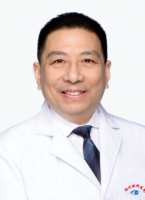什么是VDT?VDT与干眼的关系
什么是VDT?VDT是视视屏终端,即video display terminal的首字母缩写简称。VDT包括手机、个人电脑、平板电脑(pad)、电视、游戏机等电子设备。
长时间使用VDT的人,很可能会表现出下述七种症状:1、眼疲劳;2、眼干;3、眼结膜充血;4、视力下降;5、头痛;6、肩痛;7、腰痛。
因此,长时间使用VDT与干眼有密切的关系,尤其是干眼中最常见的类型睑板腺功能障碍(meibomian gland dysfunction, MGD)。长时间注视VDT可能是导致MGD的原因之一。长时间使用电脑和手机者常自述眼疲劳、眼部烧灼、刺痛、眼红、视力模糊和眼干涩等。这些症状是由于长时间注视VDT,眨眼的频率下降引起的一种反复的视疲劳症状。Wu等发现长时间使用电脑者(>4小时/天),睑缘炎症较重、睑板腺油脂性状较差和睑板腺的缺失率更高[1]。一些小样本的研究发现:VDT的使用时间和MGD的严重程度存在一定的关系[2];使用VDT人群中MGD患病率高,MGD可能是导致使用VDT者出现眼部不适的原因之一[3]。新近日本进行了一项672人的干眼病调查,结果发现干眼病在中青年日本电脑使用人群中很常见,女性为76.5%,男性为60.2%,并且长期使用VDT可能是造成干眼病的原因之一[4];正常人的工作效率下降约3.56%,而疑似干眼病受访者和确诊的干眼病受访者分别为4.06%和4.82%,说明干眼病会导致工作效率显著降低[5]。确诊的干眼病受访者的体育活动明显少于非干眼病受访者,而静坐时间明显长于后者[6]。干眼病的症状还与主观幸福感、睡眠质量均呈负相关[7,8]。综上,MGD的发生不仅与长时间使用VDT,还与运动、睡眠质量等生活方式有关,而且可以影响自我的主观幸福感,并造成工作效率的降低。
放下手机等VDT,多参加户外运动,保持良好的睡眠等,这些良好的生活习惯是远离干眼的最佳途径!
肖湘华
陕西省眼科研究所
西安市第一医院
参考文献:
1. Wu, H., et al., Meibomian gland dysfunction determines the severity of the dry eye conditions in visual display terminal workers. PLoS One, 2014. 9(8): www.yihu.com105575.
2. Fenga, C., et al., Work and video terminals: eye discomfort and www.yihu.com data. G Ital Med Lav Ergon, 2003. 25 Suppl(3): p. 208-9.
3. Fenga, C., et al., Meibomian gland dysfunction and ocular discomfort in video display terminal workers. Eye (Lond), 2008. 22(1): p. 91-5.
4. Uchino, M., et al., Prevalence of dry eye disease and its risk factors in visual display terminal users: the and work productivity loss in visual display users: the Osaka study. Am J Ophthalmol, 2014. 157(2): p. 294-300.
6. Kawashima, M., et al., The Association between Dry Eye Disease and Physical Activity as well as Sedentary Behavior: Results from the Osaka Study. J Ophthalmol, 2014. 2014: p. 943786.
7. Kawashima, M., et al., Associations between subjective happiness and dry eye disease: a new perspective from the Osaka study. PLoS One, 2015. 10(4): www.yihu.com0123299.
8. Kawashima, M., et al., The association of sleep quality with dry eye disease: the Osaka study. Clin Ophthalmol, 2016. 10: p. 1015-21.
Osaka study. Am J Ophthalmol, 2013. 156(4): p. 759-66.






 闽公网安备 35010202000982号
闽公网安备 35010202000982号
